Product Images Methylphenidate Hydrochloride
View Photos of Packaging, Labels & Appearance
Product Label Images
The following 14 images provide visual information about the product associated with Methylphenidate Hydrochloride NDC 31722-954 by Camber Pharmaceuticals, Inc., such as packaging, labeling, and the appearance of the drug itself. This resource could be helpful for medical professionals, pharmacists, and patients seeking to verify medication information and ensure they have the correct product.
18 mg
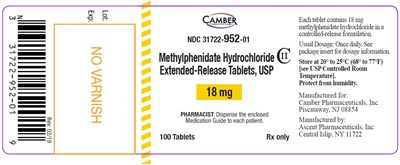
This is a medication description for Methylphenidate Hydrochloride Extended-Release Tablets, USP. Each tablet contains 18 mg of methylphenidate hydrochloride in a controlled-release formulation. The recommended dosage is once daily and should be determined according to the package insert. The tablets should be stored at 20° to 25°C (68°to 77°F) and protected from humidity. The medication is manufactured by Ascent Pharmaceuticals, Inc. and distributed by Camber Pharmaceuticals, Inc. Pharmacists are advised to dispense the enclosed medication guide to each patient.*
27 mg
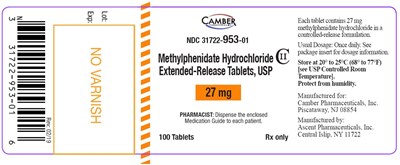
This is a description for a medication called Methylphenidate Hydrochloride Extended-Release Tablets. Each tablet contains 27 mg of Methylphenidate Hydrochloride in a controlled-release formulation. The usual dosage is once daily, and the package insert should be consulted for more information on dosage. The tablets should be stored at 20° to 25°C (68° to 77°F) in a controlled room temperature and protected from humidity. The medication is manufactured by Ascent Pharmaceuticals, Inc. and distributed by Camber Pharmaceuticals, Inc. A pharmacist should dispense the enclosed medication guide to each patient with a prescription.*
54 mg
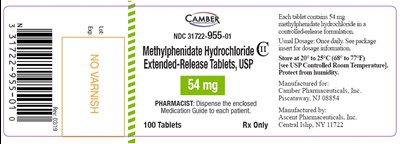
U AMBER is a medication containing 54 mg of methylphenidate hydrochloride in a controlled-release formulation. The usual dosage is once daily and the medication comes in the form of extended-release tablets. The medication should be stored at controlled room temperature and protected from humidity. The manufacturer is Camber Pharmaceuticals, Inc. and the medication guide should be dispensed to each patient. The package insert has dosage information.*
Figure2
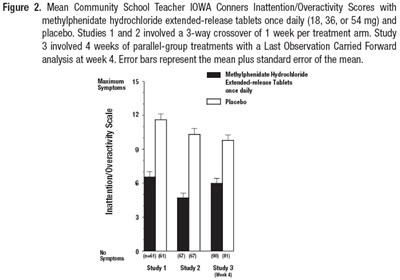
The provided text describes a figure (Figure 2) that shows the mean scores of Community School Teachers for IOWA Conners Inattention/Overactivity with methylphenidate hydrochloride extended-release tablets (18, 36, or 54 mg) taken once daily and with placebo. The scores are based on three studies, two of which involved a 3-way crossover of 1 week per treatment arm, and one involved four weeks of parallel-group treatments. The figure includes error bars that represent the mean plus standard error of the mean.*
Figure3
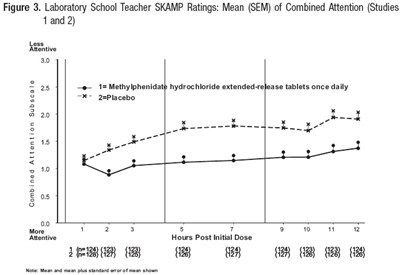
The image is a graph plotting the mean scores of the "Combined Attention Subscale" of SKAMP ratings for laboratory school teachers. Study 1 and Study 2 are combined in the graph, and the scores are measured in units of attentive hours post-initial dose. The data is separated into two groups, one that received methylphenidate hydrochloride extended-release tablets once daily and the other receiving a placebo. The scores show that the group that received the medication had higher scores for the Combined Attention Subscale compared to the placebo group at each hour post-initial dose.*
Table1

The table provides the recommended starting doses and dose ranges for Methylphenidate Hydrochloride Extended-Release Tablets based on the patient's age. The recommended starting dose for children (6-12 years) is 18mg/day with a dose range of 18mg - 54mg/day. Similarly, for adolescents (13-17 years) it's 18mg/day with a dose range of 18mg - 72mg/day, not to exceed 2mg/kg/day. For adults (18-85 years), the recommended starting dose is 18mg or 36mg/day with a dose range of 18mg - 72mg/day.*
Table2

This is a table that shows the recommended dose conversion from previous methylphenidate regimens to methylphenidate hydrochloride extended-release tablets. It lists the previous daily dose of methylphenidate and the corresponding starting dose of the extended-release tablets.*
Table3

This is a table showing the exposure of Methylphenidate Hydrochloride Extended-Release Tablets in double-blind and open-label clinical studies for children, adolescents, and adults. It includes the size of the patient population, dose range, and frequency of administration.*
Table4

Table 4 shows the adverse reactions reported by children and adolescents taking Methylphenidate Hydrochloride Extended-Release Tablets in four placebo-controlled, double-blind clinical trials. The table lists the system/organ class, adverse reactions, number of subjects treated with the drug and placebo, and the corresponding percentages. The most common adverse reactions reported were vomiting, nasal-pharyngitis, insomnia, abdominal pain, pyrexia, cough, dizziness, and oropharyngeal pain. Initial insomnia and insomnia were combined into insomnia.*
Table5

Table 6 shows adverse reactions reported by 21% of subjects who were given Methylphenidate Hydrochloride in a double-blind, randomized trial. The table displays the percentage of reported adverse reactions by system organ class and preferred term. Some of the reported reactions include gastrointestinal disorders, headaches, dizziness, and infections/festering. There are also mentions of metabolic and endocrine disorders, nervous system disorders, and psychiatric disorders. Details on the dosage administered and duration of the study are not available.*
Table6
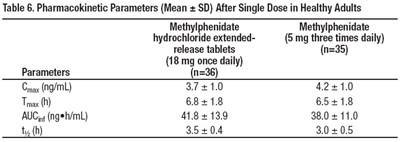
Table 6 shows the pharmacokinetic parameters of Methylphenidate and Methylphenidate hydrochloride extended-release tablets in healthy adults. The table displays the mean and standard deviation of 35 subjects who took 5 mg of Methylphenidate thrice daily and 36 subjects who took 18 mg of Methylphenidate once daily. The parameters measured were Cmax, Trnax, and AUC which represent the maximum plasma concentration, the time to reach the maximum concentration, and the area under the plasma concentration-time curve, respectively. There is no useful information that can be extracted from the last line that shows some numbers without context.*
* The product label images have been analyzed using a combination of traditional computing and machine learning techniques. It should be noted that the descriptions provided may not be entirely accurate as they are experimental in nature. Use the information in this page at your own discretion and risk.


